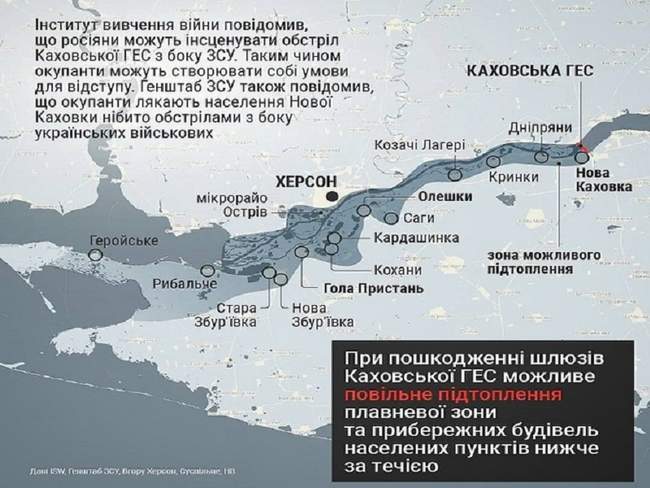Меню
Social networks
Sections
June 8, 2023, 12:12 p.m.
IAEA Statement: Even worse tragedy could happen due to the undermining of the Kakhovka HPP dam
Цей матеріал також доступний українською1575

Photo by the Institute for the Study of War
The water level in the Kakhovka reservoir continues to fall as a result of the attack on the hydroelectric power plant. Therefore, ZNPP is working to ensure the maximum amount of cooling water in reserve.
This was stated by IAEA Director General Rafael Mariano Grossi.
The water level in the reservoir decreased by about 2.8 meters after the dam was blown up and reached 14.03 meters. The hourly rate of loss has slowed slightly to 5-7 cm/hour. If the level drops below 12.7 meters, ZNPP will no longer be able to pump water from the reservoir to the site.
Since the full extent of the dam's damage remains unknown, it is impossible to predict when this will happen. If the current rate of fall continues, the 12.7-meter level could be reached within the next two days.
Director General Grossi will visit ZNPP next week to assess the situation after the dam was damaged.
In his turn, Petro Kotin, President of Energoatom, said on the air of the telethon "United News", answering questions about the current situation at Zaporizhzhya NPP and threats to the plant after the destruction of Kakhovka HPP, that the water level in the Kakhovka reservoir is 13.5 meters, while the normal level is 16.5 meters.
According to him, the water level in the ponds located on the territory of Zaporizhzhia NPP is currently 16.6 meters. This is expected, because these ponds are separated from the Kakhovka reservoir.
However, Energoatom has a list of urgent measures that it will take if the situation worsens. For example, in case of loss of water level in the cooling ponds.
"The best case scenario for us is to expel these invaders from Zaporizhzhia NPP as soon as possible and transfer the plant under Energoatom's control, and then we will ensure the operation and maintenance of this civilian facility," said Petro Kotin.
Intent is monitoring the situation in the region after the dam of the Kakhovka hydroelectric power plant was blown up.
The State Emergency Service reported that as of 8:00 a.m. on June 8, 1,995 people, including 103 children, had been evacuated from the flooded areas.
334 people were rescued, including 15 children. Psychological assistance was provided to 168 people. Nine evacuation centers have been set up. Since the start of the work, the Rescue Service has received 631 calls from citizens.
According to preliminary data, a total of 20 settlements and 2,629 houses on the right bank of the Dnipro River have been flooded.
About 1,850 people and more than 345 pieces of equipment are involved in the relief efforts, including 810 rescuers and 226 pieces of equipment, including 42 watercraft.
It is also known that on May 6, an urgent evacuation of those areas that fall within the flood zone on the Dnipro coast began in the liberated territory of Kherson region. The evacuation has already begun from the areas of Kherson city and villages where flooding is taking place.
According to the South Command, the Russian occupation forces blew up the Kakhovka hydroelectric power plant.
Units of the National Police and the State Emergency Service of Kherson region have been put on alert to warn and evacuate civilians from potential flood zones on the right bank of the Dnipro River, namely the villages of Mykolayivka, Olhivka, Lovo, Tyahynka, Ponyativka, Ivanivka, Tokarivka, Ponyativka, Prydniprovske, Sadove, and partially the city of Kherson - Korabel Island.
Also, due to the dam's undermining, a noticeable rise in water was recorded on the beaches of Namiv, Korabelnyi district, Soliani neighborhood, at the yacht club, and in some areas of Velyka Korenyha and Shyroka Balka in Mykolaiv.
In the city, "ELU Avtodorog" specialists flooded the pontoon bridge leading to the Alyauda Peninsula. This is necessary to preserve the crossing itself, as the water level rises, the bridge itself rises, which can damage it or even destroy it.
People can still walk across the flooded bridge and passenger cars can drive through, but large vehicles can no longer do so.











